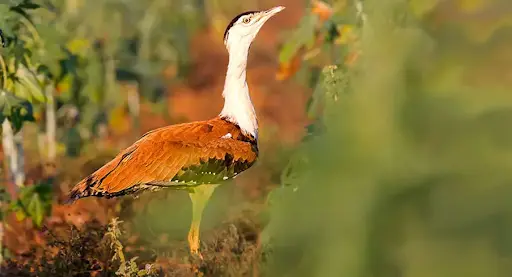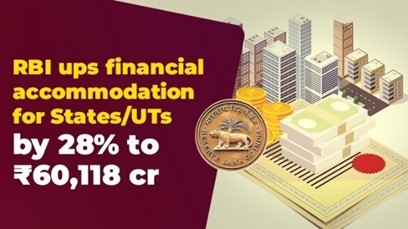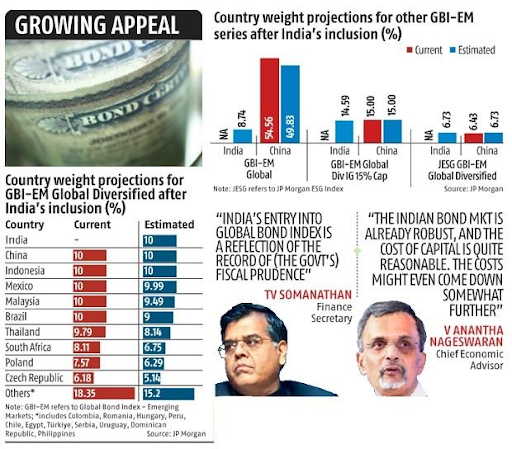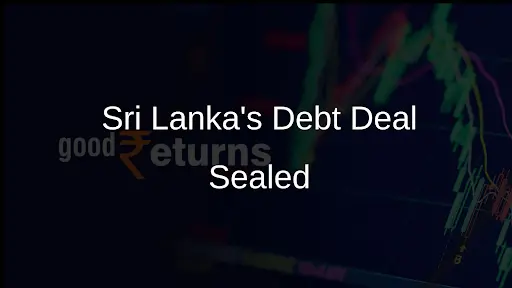Wednesday, 3rd July 2024
PLI Scheme to Boost Recycling of Critical Minerals in India
Why in the news?
- Recently, the Ministry of Mines is designing a Production Linked Incentive (PLI) scheme to encourage the recycling of critical minerals in India.
- This scheme aims to complement the Battery Waste Management Rules (BWMR) 2022 and align with NITI Aayog's policy recommendations.

What are Critical Minerals?
- Definition:
- Critical minerals are those with a higher risk of supply shortage and significant economic impact compared to other raw materials.
- They are essential for economic development and national security. Their limited availability or concentration in a few geographical locations could lead to supply chain vulnerabilities.
- Importance:
- These minerals, such as lithium, graphite, cobalt, titanium, and rare earth elements, are crucial for sectors like high-tech electronics, telecommunications, transport, and defence.
- They are part of multiple strategic value chains, including:
- Clean technologies (e.g., zero-emission vehicles, wind turbines, solar panels)
- Information and communication technologies (e.g., semiconductors)
- Advanced manufacturing inputs and materials (e.g., defence applications, permanent magnets, ceramics)
- India's Position:
- India has not been a dominant player in the global supply chain for various critical minerals but is working to strengthen its position in mining and processing these minerals.
- The Ministry of Mines is actively engaging with resource-rich countries and domestic exploration to secure access to critical minerals.
Measures Initiated by the Government of India to Attain Self-Reliance in Critical Minerals:
- Geological Survey of India (GSI):
- The GSI has conducted mineral exploration in Salal-Haimna areas (Reasi district, J&K) and estimated 5.9 million tonnes of lithium ore.
- Khanij Bidesh India Ltd (KABIL):
- This joint venture company is tasked with identifying and acquiring overseas mineral assets of critical and strategic nature (e.g., lithium, cobalt) to ensure supply-side assurance.
- Mineral Security Partnership (MSP):
- India has been inducted into the MSP, a US-led collaboration of 14 countries aiming to catalyse public and private investment in critical mineral supply chains globally.
- The Mines and Minerals (Development and Regulation) [MMDR] Act:
- The MMDR Act 1957 was amended in 2023, empowering the central government to exclusively auction mining leases and composite licences for 24 critical minerals.
- This amendment aims to increase exploration and mining of critical minerals and ensure self-sufficiency in their supply.
Recycling of Critical Minerals in India:
- Opportunity for India:
- India is the third-biggest contributor to e-waste, with 3.3 million tonnes produced in 2019, compared to 53.6 million tonnes globally.
- E-waste contains reusable materials, including base metals, precious metals, and rare earth elements, providing a large scope for critical minerals’ recovery from discarded e-waste in the coming years.
- Advantages of Recycling Critical Minerals:
- Promoting e-waste recycling would stabilise the market with assured domestic supplies of critical raw materials (CRMs).
- It conserves energy and the environment by reducing the need for mining.
- Recycled metals can be 2 to 10 times more energy-efficient than metals smelted from virgin ore.
- Challenges for India:
- India's e-waste generation is expected to surge, driven by growth in solar and wind energy infrastructure and EV adoption.
- Current recycling rates in India are low, with some success in recycling lead, copper, and nickel.
- Much of the e-waste management in India is done by the informal sector, including collection, segregation, dismantling, and recycling.
- Steps Taken by India:
- The BWMR 2022 requires the recycling of used EV lithium-ion batteries in a phased manner starting in 2026.
- These rules mandate that producers of batteries containing lithium, nickel, cobalt, and lead ensure environmentally sound management of waste batteries through Extended Producer Responsibility (EPR) compliance.
Proposed PLI Scheme to Boost the Recycling of Critical Minerals in India:
- Background:
- In a 2023 report, NITI Aayog recommended a PLI scheme for critical mineral recycling, similar to the Advanced Chemistry Cell (ACC) PLI scheme given to cell manufacturers.
- About the Scheme:
- The PLI scheme will target e-waste recycling (often referred to as “urban mining”) to recover critical minerals such as lithium, copper, cobalt, graphite, chromium, and silicon.
- It will incentivize the production of recycled critical minerals for secondary use and promote investment in advanced recycling technologies and infrastructure.
- The quantum of incentive is likely to vary based on the type and value of minerals recycled.
- Objective:
- The scheme aims to foster a circular economy and bolster domestic supply chains, following a weak response to recent auctions of critical mineral blocks.
|
UPSC Civil Services Examination Previous Year Question (PYQ) Prelim: Q:1 Consider, the following statements : (2023) Statement-I : India accounts for 3.2% of global export of goods. Statement-II : Many local companies and some foreign companies operating in India have taken advantage of India's ‘Production-linked Incentive’ scheme. Which one of the following is correct in respect of the above statements?
Ans: (d) Q:2 .Consider the following minerals: (2020)
In India, which of the above is/are officially designated as major minerals?
Ans: D Q:3 .Recently, there has been a concern over the short supply of a group of elements called ‘rare earth metals’. Why? (2012)
Which of the statements given above is/are correct?
Ans: C Mains: Q:1 Discuss the multi-dimensional implications of uneven distribution of mineral oil in the world. (2021) |
Source: IE
Improving Rural Connectivity
Why in the News?
- Recently, IEEE approved a wireless network architecture for affordable broadband access in rural areas, developed at IIT Bombay.
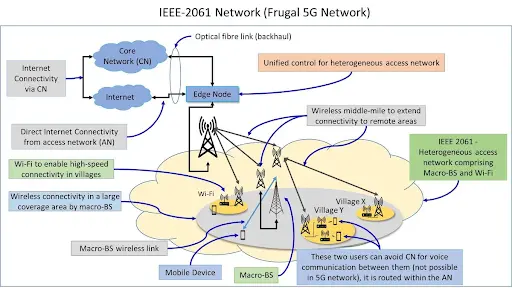
Fundamentals of Cellular Network:
- Definition:
- A cellular network, such as a 5G network, includes a set of network equipment connected by communication links. They work together to move data between different devices and to other networks, e.g., the Internet.
- A cellular network can be divided into two sub-networks: the Access Network (AN) and the Core Network (CN).
- Access Network (AN):
- The AN includes base stations that provide wireless connectivity to mobile devices within a specific area, known as the coverage area.
- These base stations are typically seen as towers with antennae boxes on top and are installed throughout the region by a network operator.
- Core Network (CN):
- The CN contains equipment that connects to other networks, like the Internet.
- The CN is centrally located and connected to base stations via optical fibre links called backhaul.
- The CN is crucial for maintaining user mobility, a key feature of cellular networks.
Challenges of Mobile Connectivity in Rural Areas in India:
- Urban-Rural Digital Divide:
- Cellular network availability and usage differ greatly between urban and rural areas, especially in developing countries like India.
- Urban areas have a tele-density of 127%, meaning each person on average has more than one mobile connection.
- Rural areas have a tele-density of 58%, meaning only about half the rural population has a mobile connection.
- Reasons for Lack of Sufficient Mobile Connectivity in Rural Areas:
- Lower income of rural residents makes mobile services too expensive for many.
- Lower population densities, scattered populations, and remote locations make infrastructure deployment challenging and costly.
- Most research and development in cellular networks focus on urban needs in developed countries, leading to rural connectivity lagging significantly.
IIT-Bombay Develops Wireless Network Architecture IEEE 2061-2024 Standard:
- IEEE 2061-2024 Standard:
- The IEEE 2061-2024 standard defines a wireless network architecture for affordable broadband access in rural areas.
- Approved on June 6 by the Institute of Electrical and Electronics Engineers (IEEE).
- The network includes a CN and AN similar to cellular networks but features a heterogeneous AN where different types of base stations coexist, unlike the homogeneous AN in 5G networks.
- Middle Mile Network:
- Proposes the use of a multi-hop wireless middle-mile network to extend connectivity to areas where optical-fibre links are unavailable.
- Provides cost-effective connectivity over long distances, eliminating the need for costly optical fibre deployment.
- Offers a direct and alternative path to the Internet, unlike 4G/5G networks that connect only through the CN.
- Allows direct communication between nearby users within the AN, avoiding the CN.
About BharatNet Project:
- Objective:
- BharatNet is the world's largest optical fibre-based rural broadband connectivity project, executed by Bharat Broadband Network Limited (BBNL) under the Telecom Ministry.
- It aims to bring broadband internet connectivity to over 2.5 lakh gram panchayats across the country.
- Features & Benefits:
- The program uses optical fibre to provide a minimum of 100 Mbps bandwidth at each Gram Panchayat.
- The Centre will provide last-mile connectivity through Wi-Fi and other means, setting up Wi-Fi hotspots in all gram panchayats.
- Progress So Far:
- Initially aimed to cover 2.5 lakh gram panchayats by August 2021, but the deadline was missed.
- Around 1.94 lakh villages have been connected, with the rest expected to be connected in the next 2.5 years.
- The project's progress was affected by the COVID-19 pandemic.
- The project deadline has been extended to 2025 as per the Union Budget 2022-23.
|
UPSC Civil Services Examination Previous Year’s Question (PYQs) Prelims: Q:1 The Multi-dimensional Poverty Index developed by Oxford Poverty and Human Development Initiative with UNDP support covers which of the following? (2012)
Select the correct answer using the codes given below:
Ans: (a) Mains Q:1 Despite Consistent experience of high growth, India still goes with the lowest indicators of human development. Examine the issues that make balanced and inclusive development elusive. (2016) |
Source: TH
RBI Signed Project Nexus
Why in the news?
- The Reserve Bank of India (RBI) has joined Project Nexus, a multilateral initiative aimed at enabling instant cross-border retail payments by interlinking domestic Fast Payments Systems (FPSs).

- Through this project, India's Unified Payments Interface (UPI) will connect with the FPSs of Malaysia, the Philippines, Singapore, and Thailand, with potential expansion to other countries.
Bank for International Settlements (BIS):
About:
- Establishment: Founded in 1930, BIS is the oldest global financial institution.
- Headquarters: Located in Basel, Switzerland.
- Main Functions:
- Central Bank Cooperation: Facilitates collaboration among central banks, providing a platform for policy discussions and decision-making.
- Financial Stability: Promotes monetary and financial stability through research, policy analysis, and international standards development.
- Banking Services: Offers banking services to central banks and international organisations, including gold and foreign exchange transactions.
- Economic Research: Conducts research and analysis on global economic and financial issues, producing reports and publications.
Importance:
- Coordination: Acts as a forum for central banks to collaborate on monetary policy and financial regulation.
- Standard Setting: Plays a crucial role in setting international standards to ensure the stability and resilience of the global financial system.
- Crisis Management: Provides a platform for coordinated responses to global financial crises and economic challenges.
Notable Works:
- Basel Accords:
- Basel I (1988): Introduced minimum capital requirements for banks to reduce credit risk.
- Basel II (2004): Expanded on Basel I by adding requirements for market and operational risk, emphasising risk management.
- Basel III (2010-2017): Strengthened bank capital requirements, introduced new regulatory requirements on liquidity and leverage, and aimed to enhance banking sector resilience post-2008 financial crisis.
- BIS Innovation Hub: Established to foster collaboration on financial technology (FinTech) and innovation among central banks, focusing on digital currencies, cybersecurity, and new financial technologies.
- Financial Stability Board (FSB) Support: Played a crucial role in establishing and supporting the FSB, which coordinates international efforts to enhance global financial stability and regulatory reforms in response to the 2008 financial crisis.
Project Nexus:
- Background:
- The RBI has been working bilaterally with various countries to link India’s UPI with their FPSs for cross-border Person to Person (P2P) and Person to Merchant (P2M) payments.
- A multilateral approach through Project Nexus can significantly enhance the international reach of Indian payment systems.
- Currently, over 70 countries have instant payment systems that enable domestic payments to reach their destination in seconds at near-zero cost.
- By interconnecting these systems, cross-border payments can be completed within 60 seconds in most cases.
- About:
- Project Nexus is conceptualised by the Innovation Hub of BIS.
- It seeks to enhance cross-border payments by connecting multiple domestic instant payment systems (IPS) globally.
- It is the first BIS Innovation Hub project in the payments area moving towards live implementation.
- Benefits:
- Project Nexus aims to standardise the interconnection of Instant Payment Systems (IPS).
- Instead of each payment system operator creating custom connections for every new country, they can connect once to the Nexus platform.
- This single connection enables access to all other countries on the network, potentially accelerating the growth of instant cross-border payments.
- Countries that have joined the platform:
- Project Nexus aims to connect the FPSs of four Association of Southeast Asian Nations (ASEAN) — Malaysia, Philippines, Singapore, and Thailand; and India.
- These countries would be the founding members and first movers on this platform.
- Indonesia will also join the platform in the future.
|
UPSC Civil Services Examination, Previous Year Question (PYQ) Prelims Q1. With reference to digital payments, consider the following statements: (2018)
Which of the statements given above is/are correct?
Ans: (a) Q2. Which of the following is a most likely consequence of implementing the ‘Unified Payments Interface (UPI)’? (2017)
Ans: (a) Q: 3. Consider the following statements: (2017)
Which of the statements given above is/are correct?
Ans: (c) |
Source: IE
Deep Brain Stimulation (DBS) Device
Why in the news ?
- Recently, a UK-based teenager has become the first person in the world to be fitted with a deep brain stimulation (DBS) device to help control his epileptic seizures.
- The DBS device sends electrical signals deep into the brain and has reportedly reduced his daytime seizures by 80%.
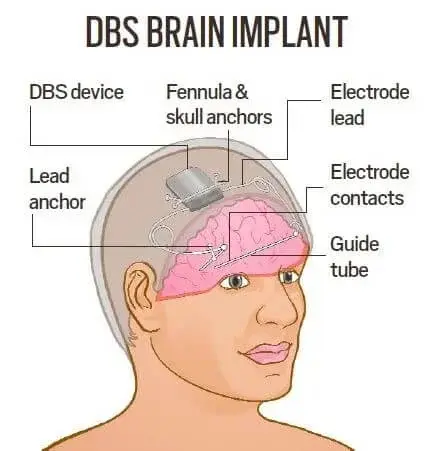
What is Epilepsy?
- Definition: Epilepsy refers to "seizure disorders," characterised by sudden surges of abnormal and excessive electrical activity in the brain.
- Symptoms: During seizures, a person may experience jerking of arms and legs, temporary confusion, staring spells, or stiff muscles.
- Risks: Seizures can increase the risk of accidents, drownings, and falls.
- Causes: The cause is unknown in nearly 50% of cases. Potential causes include head trauma, brain tumours, infections like meningitis, and genetic factors.
- Prevalence: According to a 2022 Lancet study, between 3 and 11.9 per 1,000 people in India suffer from epilepsy.
- Treatment Resistance: Although several anti-seizure medicines are available, 30% of patients remain resistant to treatment.
What is Deep Brain Stimulation (DBS)?
- About: DBS is a neurosurgical procedure that uses implanted electrodes and electrical stimulation to treat movement disorders associated with Parkinson’s disease (PD), essential tremor, dystonia, and other neurological conditions.
- Working:
- Implantation: Neurosurgeons implant one or more leads (wires) inside the brain.
- Connection: The leads are connected to an insulated wire extension and a small neurostimulator (electrical generator) implanted under the collarbone, similar to a heart pacemaker.
- Stimulation: Continuous pulses of electric current from the neurostimulator pass through the leads into the brain, interrupting the irregular signals causing tremors and other movement symptoms.
- Adjustment: Doctors program the device to deliver the electrical signal, ensuring it is properly adjusted to balance symptom control and side effects.
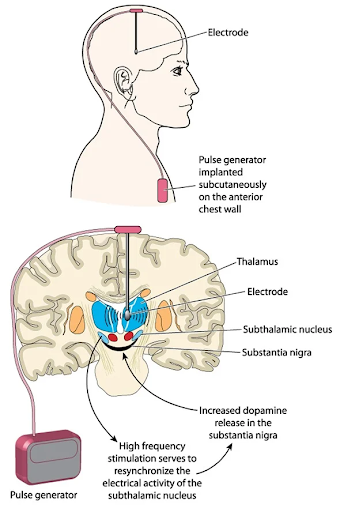
Other Alternatives to Treat Epilepsy
- Initial Treatments: Doctors first use anti-seizure medicines and a ketogenic diet (high in fats, low in carbohydrates).
- Surgical Options:
- Brain Surgery: Removing the portion of the brain where seizures originate.
- Corpus Callosotomy: Removing part of the brain to prevent abnormal electrical signals from travelling between hemispheres; suggested for some children.
How Popular is DBS?
- Preference: Surgery is still preferred over implanting a DBS device due to higher effectiveness.
- Effectiveness: DBS devices reduce seizures by around 40%, whereas brain surgery can reduce seizures by nearly 90%.
- Cost:
- DBS Devices: DBS/neurostimulators cost about Rs 12 lakh, with additional surgical costs raising the total to around Rs 17 lakh in private hospitals.
- Brain Surgery: Brain surgery costs between Rs 2 and 3 lakh.
- Recommendation: DBS devices are suggested for patients whose epilepsy originates from multiple parts of the brain, making surgery less viable.
|
UPSC Civil Services Examination Previous Year Question (PYQ) Mains Q:1 What are the aims and objectives of the McBride Commission of UNESCO? What is India’s position on these? (2016) |
Source: IE
GST Completes Seven Years
Why in the news ?
- In June 2024, as the Goods and Services Tax (GST) celebrated its seventh anniversary, the gross monthly collection amounted to Rs 1.74 lakh crore, reflecting a 7.7% increase from the previous year.
- The introduction of GST in India was facilitated by the 101st Amendment Act of 2016, which came into effect on 1 July 2017.
- As of April 2024, the GST taxpayer base has grown to 1.46 crore, up from 1.05 crore in April 2018.
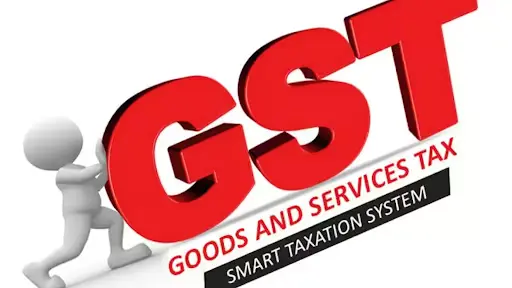
About the Goods and Services Tax (GST):
- GST is a unified tax system that replaced multiple indirect taxes previously imposed by both the Central and State Governments.
- The GST framework operates through a dual structure: Central GST (CGST) and State GST (SGST), administered concurrently by the Central and State governments, respectively.
- Additionally, Integrated GST (IGST) is levied on interstate supplies and imports. While collected by the Central Government, it is distributed to the destination state.
About the Goods and Services Tax (GST) Council:
- The Goods and Services Tax (GST) Council is a constitutional body established under Article 279A of the Indian Constitution through the 101st Amendment Act of 2016.
- The Union Finance Minister serves as the Chairperson of the GST Council.
- The GST Council advises both the Union and State governments on various GST-related issues, including:
- Subsuming taxes, cesses, and surcharges under GST.
- Deciding which goods and services should be subject to or exempt from GST.
- Developing model GST laws, principles of levy, and apportionment of Integrated GST (IGST).
- Setting tax rates, thresholds, special provisions, and other GST-related matters.
- Dispute resolution: The GST Council also acts as a platform to resolve disputes between the Centre and the States, or among the States themselves, concerning GST matters.
- Voting power: The Centre holds one-third of the total voting power in the GST Council, while the States collectively hold two-thirds
Salient Features of GST:
- One Nation, One Tax: GST streamlined the tax structure nationwide, eliminating tax cascading.
- Destination-based Tax: GST is applied based on the final consumption destination, across all stages of the supply chain.
- Input Tax Credit (ITC): Businesses can claim credit for taxes paid on inputs, reducing overall tax liability and avoiding double taxation.
- Online Compliance: The Goods and Services Tax Network (GSTN) facilitates online registration, return filing, tax payment, and compliance activities.
- Anti-Profiteering Measures: The National Anti-Profiteering Authority (NAA) ensures businesses do not unfairly raise prices post-GST implementation.
- Composition Scheme: Simplifies tax compliance for small taxpayers with turnover below a set threshold, requiring payment of a fixed GST percentage.
Challenges:
- Refund Delay Issues: Despite government efforts to streamline processes, delays in export refunds and automatic processing remain significant concerns.
- Adoption & Technical Issues: Small and medium businesses face challenges in adapting to the technology-driven GST framework, impacting compliance and operational efficiency.
- Concerns Highlighted by 15th Finance Commission:
- Multiplicity of Tax Rates: The varying tax rates across goods and services complicate compliance and administration.
- Shortfall in GST Collections: Actual GST collections often fall short of forecasted targets, affecting revenue projections and fiscal planning.
- High Volatility in GST Collections: Fluctuations in GST revenues pose challenges for budgetary stability and economic planning.
- Inconsistency in Filing of Returns: Varied compliance levels in return filing create administrative burdens and affect tax administration efficiency.
- State Dependence on Centre's Compensation: States rely on compensation from the Central Government, raising concerns about fiscal autonomy and stability.
Way forward:
- The Goods and Services Tax (GST) represents a significant milestone in India's economic journey, simplifying the indirect tax structure and promoting transparency.
- Despite initial hurdles and ongoing adjustments, GST is poised to stimulate economic growth, enhance tax compliance, and fortify the government's revenue base.
- As India's economy expands, it is crucial to refine the GST framework to effectively tackle challenges and maximise its potential benefits.
- This includes addressing issues like refund delays, technical adoption by SMEs, and streamlining tax rates.
Source: IE
Chital
Why in the news ?
- Recently, the Project Cheetah authorities have reached an in-principle decision to shift surplus cheetahs from Kuno National Park to Gandhi Sagar Wildlife Sanctuary to save the chital (spotted deer) population.

About the Chital (Spotted Deer):
- Native Species: The chital, also known as the spotted deer, chital deer, and axis deer, is indigenous to the Indian subcontinent.
- Origins: Described by Johann Christian Polycarp Erxleben.
- Biological Features: The chital is sexually dimorphic; males are larger than females, and only males possess antlers.
- Population Estimation: According to the IUCN, the Axis deer is found throughout its range, although no overall population estimate is given. The IUCN Red List classifies the Axis deer as Least Concern (LC).
About the Kuno National Park:
- Location: Situated in the Sheopur district of Madhya Pradesh, near the Vindhyan Hills. The park is named after the Kuno River, a major tributary of the Chambal River. It was originally established as a wildlife sanctuary before being designated a national park in 2018.
- Significance: Chosen as a site for the ‘Action Plan for Introduction of Cheetah in India.’
- Fauna: Hosts species such as the jungle cat, Indian leopard, sloth bear, Indian wolf, striped hyena, golden jackal, Bengal fox, and dhole.
- Flora: The forested areas are predominantly occupied by Kardhai, Salai, and Khair trees, constituting a mixed forest environment. The park boasts diverse plant life, including 123 tree species, 71 shrub species, 32 exotic and climbing species, and 34 species of bamboo and grass.
Source: IE
Global IndiaAI Summit 2024
Why in the news ?
- Recently, the Ministry of Electronics and Information Technology is organising the ‘Global IndiaAI Summit’ in New Delhi.
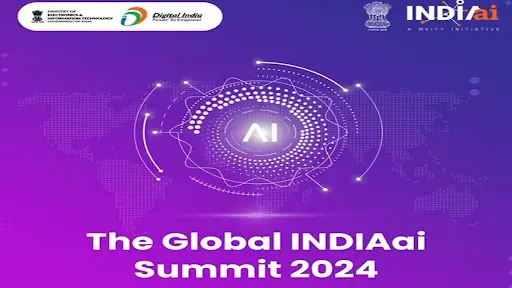
About the Global India AI Summit 2024:
- Objective: The event underscores the Government of India’s dedication to the responsible advancement of AI, fostering collaboration and knowledge exchange among global AI stakeholders.
- Leadership Role: As the lead chair of the Global Partnership on Artificial Intelligence (GPAI), India will host member countries and experts to advance GPAI’s commitment to safe, secure, and trustworthy AI.
About IndiaAI Mission:
- Ministry: Under the Ministry of Electronics and Information Technology.
- Goal: Aims to ensure a structured implementation of the India AI mission through a public-private partnership model to nurture India’s AI innovation ecosystem.
- Implementation: Implemented by ‘IndiaAI’ Independent Business Division under Digital India Corporation (DIC).
Key Pillars of IndiaAI Mission:
- IndiaAI Compute Capacity:
- Establishing a scalable AI computing ecosystem with over 10,000 GPUs through public-private partnerships.
- An AI marketplace will provide AI as a service and pre-trained models, acting as a central hub for essential AI resources.
- IndiaAI Innovation Centre:
- Focused on developing and deploying indigenous large multimodal models (LMMs) and domain-specific foundational models.
- These models will cater to the unique needs of India's diverse industries and sectors.
- IndiaAI Datasets Platform:
- Streamlining access to high-quality non-personal datasets for AI innovation.
- A unified data platform will provide seamless access for Indian startups and researchers, aiding in the development of robust AI models.
- IndiaAI Application Development Initiative:
- Promoting AI applications in critical sectors by addressing problem statements from Central Ministries, State Departments, and other institutions.
- This initiative focuses on developing impactful AI solutions for large-scale socio-economic transformation.
- IndiaAI FutureSkills:
- Reducing barriers to AI education by increasing AI courses at various academic levels and establishing Data and AI Labs in Tier 2 and 3 cities.
- This ensures a steady pipeline of skilled AI professionals nationwide.
- IndiaAI Startup Financing:
- Supporting deep-tech AI startups with streamlined access to funding.
- By providing risk capital and financial support, the mission aims to nurture a vibrant ecosystem of AI startups driving technological advancements and economic growth.
- Safe & Trusted AI:
- Ensuring responsible AI development through implementing Responsible AI projects, developing indigenous tools and frameworks, and establishing guidelines for ethical, transparent, and trustworthy AI technologies.
|
UPSC Civil Services Examination Previous Year Question (PYQ) Prelims Q:1 With the present state of development, Artificial Intelligence can effectively do which of the following? (2020)
Select the correct answer using the code given below:
Ans: (b) Q:2 The terms ‘WannaCry, Petya and EternalBlue’ sometimes mentioned in the news recently are related to (2018)
Ans: (c) Mains Q:1 What are the main socio-economic implications arising out of the development of IT industries in major cities of India? (2022) Q.:2“The emergence of the Fourth Industrial Revolution (Digital Revolution) has initiated e-Governance as an integral part of government”. Discuss. (2020) |
Source: (PIB)
Maitree Exercise 2024
Why in the news ?
- On July 1, 2024, the Maitree Exercise, a joint military exercise between the Indian Army and the Royal Thai Army, commenced at Fort Vachira Prakan in Tak Province, Thailand.
- This two-week event, running until July 15, 2024, marks a significant step in enhancing military cooperation between the two nations.

What is the Maitree Exercise?
- A Long-standing Tradition:
- Inception: Started in 2006
- Frequency: Conducted regularly between Indian and Thai armies
- Previous Exercise: Last held in September 2019 in Meghalaya, India
- Participants:
- Indian Army: 76 personnel from Ladakh Scouts and other divisions
- Royal Thai Army: 76 personnel from the 1st Battalion, 14 Infantry Regiment of 4 Division
- Goals of the Exercise:
- Boost Military Cooperation: Strengthening military ties between India and Thailand.
- Enhance Skills: Focusing on counter-insurgency and counter-terrorism operations.
- Improve Joint Planning: Refining joint planning and tactical drills.
- Promote Physical Fitness: Enhancing the physical fitness of the troops.
Key Activities During the Exercise:
- Joint Operation Center: Creating and managing a joint operation centre.
- Intelligence and Surveillance: Establishing intelligence and surveillance centres.
- Drone Utilisation: Using drones and counter-drone systems.
- Securing Landing Sites: Ensuring the security of landing sites.
- Heliborne Operations: Conducting special heliborne operations.
- Cordon and Search: Performing cordon and search operations.
Importance of Maitree Exercise:
- Strengthening Defense Ties
- Defence Cooperation: Part of broader efforts to increase cooperation in the defence sector.
- MoU on Defence Cooperation: Builds on the 2012 Memorandum of Understanding on Defense Cooperation.
- Enhancing Military Skills
- Urban and Jungle Warfare: Focuses on improving urban and jungle warfare techniques.
- Coordination: Enhances coordination between the two armies.
- Promoting Regional Stability
- Peace and Security: Contributes to peace and security in the region.
- Act East Policy: Demonstrates India’s commitment to its “Act East” policy.
India-Thailand Defense Relations:
- Maritime Neighbours:
- India and Thailand share a maritime border in the Andaman Sea, making their defence cooperation crucial for regional security.
- Other Joint Military Exercises
- Naval Exercises:
- Ex-Ayutthaya: First bilateral naval exercise held in December 2023.
- Indo-Thai CORPAT: 36th edition held in December 2023.
- Air Force Exercise:
- Ex-SIAM BHARAT: Joint exercise between Indian and Royal Thai Air Forces.
- Naval Exercises:
- Significance of the Exercise Name
- Meaning of "Maitree": Means friendship in Sanskrit, reflecting the spirit of cooperation and goodwill between India and Thailand.
Looking Ahead:
- As the Maitree Exercise 2024 begins, it represents more than just a military drill.
- It is a celebration of the growing partnership between India and Thailand, contributing to regional peace and stability.
- The exercise showcases the commitment of both nations to work together in facing common challenges and strengthening their defence capabilities.
Source: (PIB)
Human Space Flight Programme
Why in the news?
- US-based Space Exploration and Research Agency (SERA and Blue Origin have announced a collaboration with India for a human spaceflight program targeting citizens from countries with limited space access.
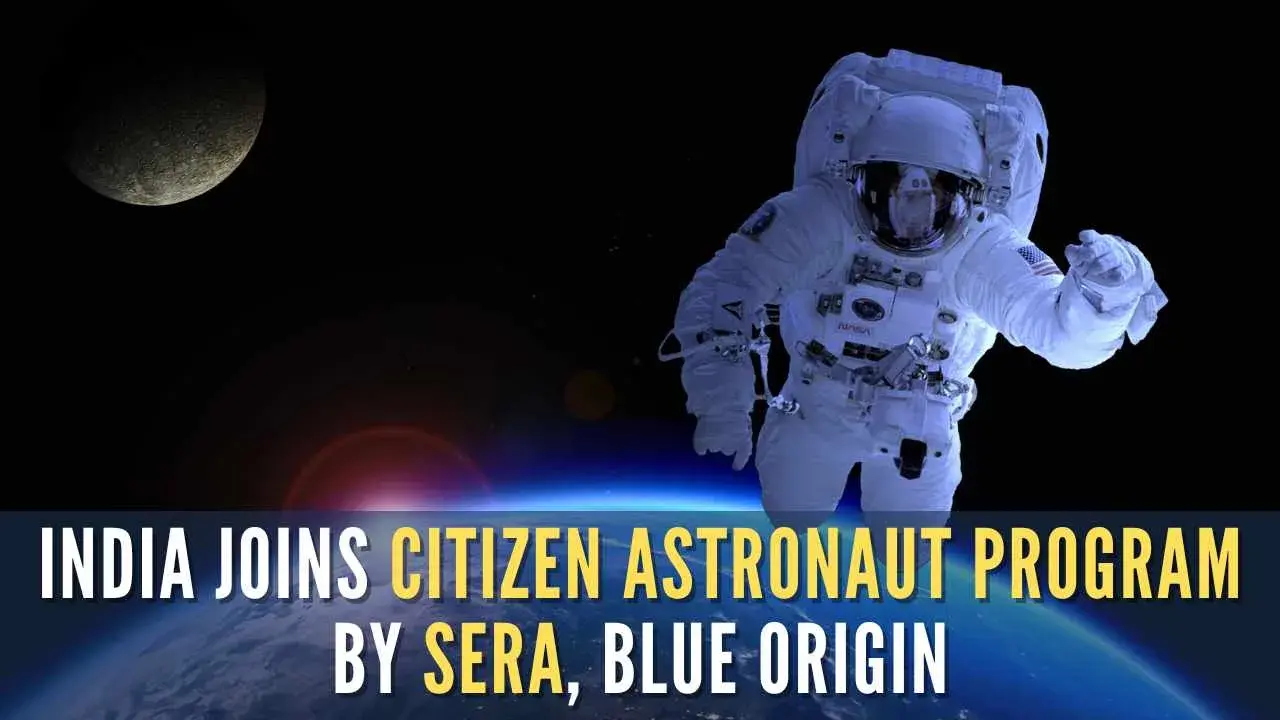
About the Human Space Flight Programme:
- Mission Details: Blue Origin will offer six seats on a future mission of its reusable suborbital rocket, New Shepard, to citizens from around the world, including India.
- Journey Highlights:
- Duration: An 11-minute journey past the Kármán line (100 km), the internationally recognised boundary of space.
- Weightlessness: Astronauts will experience several minutes of weightlessness during the controlled descent.
- Selection Process:
- The final candidate will be voted for by the public.
- Candidates can garner votes by telling their story to the public.
- Voting will progress through candidate elimination across three phases.
Human Space Flight Missions:
- Objective: To take astronauts beyond Earth’s atmosphere.
- Historical Missions:
- Vostok Program (Soviet Union): The first human flight mission, which took Yuri Gagarin to lower Earth orbit in April 1961.
- Project Mercury (USA): The first U.S. human spaceflight program.
- Apollo Program (USA): Achieved the first human landing on the Moon in 1969.
- India’s Gaganyaan Mission:
- Plan: To conduct a three-manned flight at low Earth orbit in 2024.
Significance:
- International Collaboration: This partnership underscores India's growing role in global space exploration efforts.
- Public Engagement: The public voting process engages citizens globally, promoting interest and participation in space missions.
- Technological Advancement: Highlights advancements in reusable rocket technology and its potential for regular human spaceflight.
Source: (TH)
Court on Climate Rights: India's Enforcement Path
Why in the news ?
- The recent Supreme Court judgement in M.K. Ranjitsinh and others vs. Union of India & others has significantly impacted India's emerging climate change jurisprudence.
- The Court has introduced the right to be free from the adverse effects of climate change into the Constitution of India, grounded in the rights to life and equality.
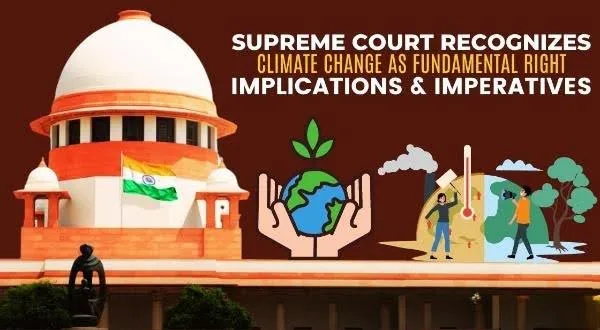
The Background of the Case:
- The case revolved around whether electricity transmission lines could be constructed through the habitat of the critically endangered Great Indian Bustard.
- The government argued that protecting the bird's habitat hindered the country's renewable energy potential.
- The Court modified a previous order to prioritise transmission infrastructure, facilitating renewable energy development to combat climate change.
- However, the judgement's most notable aspect is the introduction of the 'climate right.'
Implications of the Supreme Court’s Recognition of the Climate Right:
- Increased Climate Litigation:
- The explicit recognition of a 'climate right' empowers citizens and civil society organisations to file lawsuits demanding governmental action to protect this right.
- This could lead to a surge in climate-related cases, prompting the judiciary to interpret and enforce climate responsibilities more robustly.
- Judicial Precedents:
- As courts hear more climate-related cases, they will establish a body of jurisprudence that could influence future legal interpretations and policymaking.
- This process will gradually define the scope and content of the 'climate right' and establish legal standards for climate protection.
- Government Accountability:
- The judiciary may hold the government accountable for failing to mitigate climate change or for policies that exacerbate environmental degradation.
- This can include scrutinising projects and initiatives that negatively impact the environment or assessing the adequacy of government actions in addressing climate change.
- Policy Reformation:
- The recognition of the 'climate right' necessitates a comprehensive review and reformation of existing policies to align with the constitutional mandate.
- This includes sectors such as energy, transport, urban development, and agriculture.
- Framework for Legislation:
- There may be a push for comprehensive climate legislation that provides a coherent framework for addressing climate change.
- Such legislation would need to integrate climate considerations across all policy areas and ensure coordinated action at national and sub-national levels.
- Climate Action Plans:
- Governments at all levels may be required to develop and implement climate action plans that outline specific measures to protect the climate right.
- These plans should include both mitigation strategies to reduce greenhouse gas emissions and adaptation measures to enhance resilience against climate impacts.
Unresolved Questions Post-Judgment, Their Impact on Government Agenda and Comparison of Approaches:
- Overstatement of Clean Energy Agenda:
- The court's judgement emphasises the large-scale clean energy agenda as the primary pathway to mitigating climate change.
- There is a question if this focus might understate other critical aspects like climate adaptation and local environmental resilience.
- Ambiguity on Protection of Climate Rights:
- There is ambiguity about how the right against adverse effects of climate change will be protected.
- The judgement leaves open the method and efficacy of this protection.
- Impact on Government Agenda:
- One potential pathway forward is through a gradual accumulation of judicial decisions, which might establish a legal precedent over time.
- However, this approach might result in a fragmented, incomplete framework of protections.
- New legislation could be a more effective means of realising climate rights. This approach could provide a more comprehensive and cohesive framework.
- Comparison of Approaches:
- The court-based action involves litigation and judicial orders, and while it can lead to protections, it often requires subsequent policy actions and might not provide a unified framework.
- But new climate legislation would be more effective. Such legislation can provide a clear vision, create necessary institutions, and ensure structured governance.
- The judgement itself states that there is no ‘umbrella legislation’ in India that relates to climate change. And in so doing, it seems to implicitly recognize the merits of an overarching framework legislation.
- It can set the vision for engaging with climate change across sectors and regions, create necessary institutions and endow them with powers, and put in place processes for structured and deliberative governance in anticipation of and reaction to climate change.
Suggestions for Formulating Climate Legislation for Indian Needs:
- Customisation of Climate Legislation for India:
- While it is beneficial to learn from other countries, India's climate legislation must be tailored to its unique context rather than simply copying other nations' approaches.
- Although transitioning to a low-carbon energy future is crucial, it alone is insufficient to enforce a right against adverse climate effects.
- Setting up of Comprehensive Legislative Goals:
- The legislation should support sustainable cities, buildings, and transport networks, and this involves measures such as heat action plans that should be sensitive to local contexts.
- Also, mechanisms should be provided to shift to more climate-resilient crops. Key ecosystems like mangroves, which buffer against extreme weather, need protection.
- Moreover, consideration of social equity is essential in achieving these tasks.
- Mainstreaming Climate Change Considerations:
- Climate change considerations should be mainstreamed into India's development processes.
- A single, comprehensive law covering all areas is not feasible due to the existing legal framework and the complexity of climate change preparation.
- Learning from International Practices:
- There is scope to learn from international experience both what not to do and what directions to follow.
- Climate laws in many countries, often following the example of the United Kingdom, focus narrowly on regulating carbon emissions, for example, by setting regular five-year national carbon budgets and then putting in place mechanisms to meet them.
- This sort of approach, which has unfortunately become somewhat of a template for countries to follow, is ill-suited to India.
- Instead, because India is still developing, is highly vulnerable, and yet to build much of its infrastructure, what the country needs is a law that enables progress toward both low-carbon and climate-resilient development.
- The Factor of Federalism:
- There is another dimension essential for a climate law tailored to India: ensuring that the law works effectively within Indian federalism.
- Many areas relevant to climate action, from urban policy to agriculture and water, fall under the authority of sub-national governments — States or local levels, and electricity is also a concurrent subject.
- An Indian climate law must simultaneously set a framework for coherent national action while decentralising sufficiently to empower States and local governments, and enable them with information and finance to take effective action.
Conclusion
- The SC's recognition of the right to be free from the adverse effects of climate change as a constitutional right is a landmark decision with far-reaching implications.
- It sets the stage for transformative changes in legal frameworks, policy development, social engagement, economic strategies, and environmental conservation.
- As India navigates this new terrain, it has the opportunity to lead by example in addressing one of the most pressing global challenges of our time.
|
UPSC Civil Services Examination Previous Year Question (PYQ) Prelims: Q:1 The power of the Supreme Court of India to decide disputes between the Centre and the States falls under its (2014)
Ans: C Mains: Q:1 “The most significant achievement of modern law in India is the constitutionalization of environmental problems by the Supreme Court.” Discuss this statement with the help of relevant case laws. (2022) Q:2 Examine the scope of Fundamental Rights in the light of the latest judgement of the Supreme Court on Right to Privacy. (2017) |
Source: TH
Share the article
Get Latest Updates on Offers, Event dates, and free Mentorship sessions.

Get in touch with our Expert Academic Counsellors 👋
FAQs
UPSC Daily Current Affairs focuses on learning current events on a daily basis. An aspirant needs to study regular and updated information about current events, news, and relevant topics that are important for UPSC aspirants. It covers national and international affairs, government policies, socio-economic issues, science and technology advancements, and more.
UPSC Daily Current Affairs provides aspirants with a concise and comprehensive overview of the latest happenings and developments across various fields. It helps aspirants stay updated with current affairs and provides them with valuable insights and analysis, which are essential for answering questions in the UPSC examinations. It enhances their knowledge, analytical skills, and ability to connect current affairs with the UPSC syllabus.
UPSC Daily Current Affairs covers a wide range of topics, including politics, economics, science and technology, environment, social issues, governance, international relations, and more. It offers news summaries, in-depth analyses, editorials, opinion pieces, and relevant study materials. It also provides practice questions and quizzes to help aspirants test their understanding of current affairs.
Edukemy's UPSC Daily Current Affairs can be accessed through:
- UPSC Daily Current Affairs can be accessed through Current Affairs tab at the top of the Main Page of Edukemy.
- Edukemy Mobile app: The Daily Current Affairs can also be access through Edukemy Mobile App.
- Social media: Follow Edukemy’s official social media accounts or pages that provide UPSC Daily Current Affairs updates, including Facebook, Twitter, or Telegram channels.

